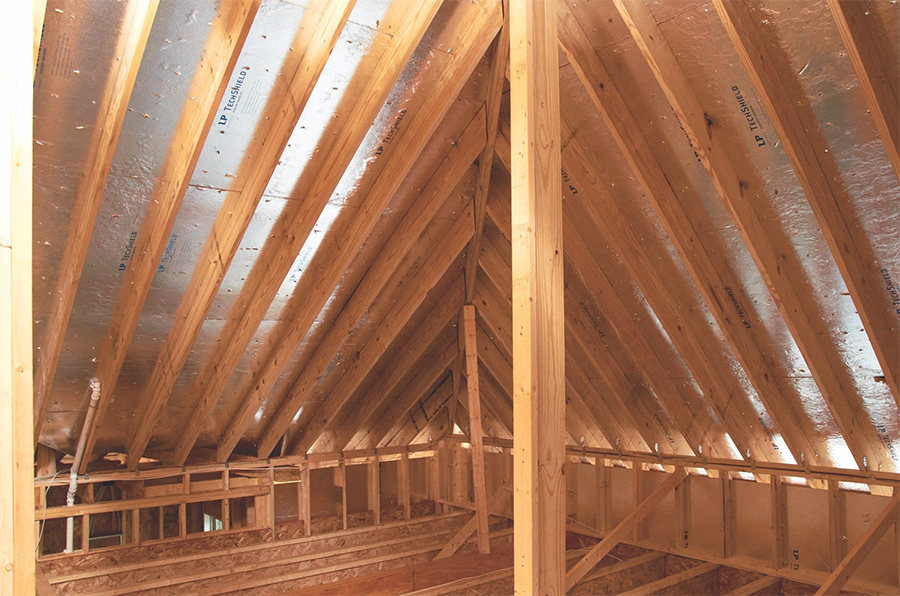Business Advice4 min
Radiant Barriers For Attic: A Quick Guide
Maybe you've been thinking about installing a radiant barrier in your attic but have a few questions. Is the upfront cost worth it in the long run? What are the advantages? What areas of the country are appropriate for a radiant barrier? How do I make sure I install it properly? Let's take a look at a few of these questions and see if a radiant barrier is right for you.
What Is Radiant Barrier Sheathing?
If you live in an area that experiences higher temperatures, you most likely also experience higher cooling costs. That’s due to the sun’s radiant energy hitting the shingles and transferring heat into the attic space. LP® TechShield® Radiant Barrier—the first OSB radiant barrier in the industry—is made by laminating a thin, durable sheet of aluminum to LP OSB Sheathing. The purity of this aluminum means the radiant barrier prevents heat absorbed in the roof sheeting from radiating into the attic, blocking up to 97% of the radiant heat in the panel from emitting into a home’s attic. According to the U.S. Department of Energy, the radiant barrier’s ability to lower heat transfer keeps attic spaces cooler by up to 30° F, which can help curb energy costs. This can also help improve the efficiency of in-attic HVAC units and reduce the tonnage of the entire system. Additionally, the VaporVents™ technology that comes with LP TechShield sheathing has small incisions along the foil that allow for any trapped moisture to escape from the panel before and after installation.
Do You Need Radiant Barrier?
As average temperatures around the country continue to climb, the thought of using a radiant barrier to cool your attic space may start to make more sense. Whereas you can almost make a case that you can use it just about anywhere, there are areas where using a radiant barrier makes the most economical sense. Typically, southern states where summers are more brutal make the most sense. Additionally, many of these states also have increased humidity. In these states the VaporVents technology that comes with LP TechShield provides an extra benefit. If you do not live in one of these hotter climates, then installing a radiant barrier in your attic is probably not the right option for you.
States Where Radiant Barrier Is Popular:
Alabama
Arkansas
Arizona
California
Florida
Georgia
Hawaii
Louisiana
Mississippi
Nevada
New Mexico
Oklahoma
South Carolina
Texas
How To Install Radiant Barrier
If you are looking to lower attic temperatures, save money on energy costs and live in a region where installing radiant barrier makes sense, it's time to install. Unlike spray foams and after-market radiant barriers, LP TechShield Radiant Barrier is rather simple to install. When working with it, you'll find that it cuts and installs like any other traditional roof deck sheathing products. You won't be required to use any special tools, and there is only one special instruction-always install LP TechShield foil down. This is key to protecting your roof and for warranty reasons.
Why Foil Down?
Even though the foil is reflective, it's not what makes a radiant barrier work. As the sun beats down on the attic, the foil absorbs the heat and allows very little of the heat to emit into the attic.

Proven To Defend Your Build™
Besides being able to protect the home from the effects of radiant heat, LP Structural Solutions has a full portfolio of products proven to defend your build. Take a look and see what other solutions are available to help you build better and more efficiently.
Continue Reading
Resiliency Solutions
5 minIntroducing LP® SmartSide® ExpertFinish® Naturals Collection™: Nature-Inspired Beauty Meets Engineered Performance
We’re excited to introduce the LP® SmartSide® ExpertFinish® Naturals Collection™, a bold new addition to our trusted line of engineered wood siding and trim that delivers the warmth and beauty of nature with the advanced protection and performance builders and homeowners expect.
Labor Solutions
5 minChoosing the Right LP® Structural Solutions Product for Your Build
When it comes to building strong, reliable, and high-performing structures, the materials you choose matter. At LP Building Solutions, we understand that every project, whether it's a single-family home or a multifamily development, requires structural components that meet your needs for strength, durability, and efficiency.
Sustainability Solutions
5 minBuilding a More Sustainable Future with LP Building Solutions
In today's world, sustainability is no longer just a buzzword, it's a blueprint for responsible living and smarter building. As the construction industry seeks ways to reduce its environmental footprint, LP Building Solutions is focused on providing innovative building materials for eco-conscious builders to help reshape what it means to build sustainably
News & Stories3 min
History of Partnership with Gary Sinise Foundation
The LP Foundation is a proud partner of the Gary Sinise Foundation, which supports wounded veterans in several ways. You can learn more about the LP Foundation here.